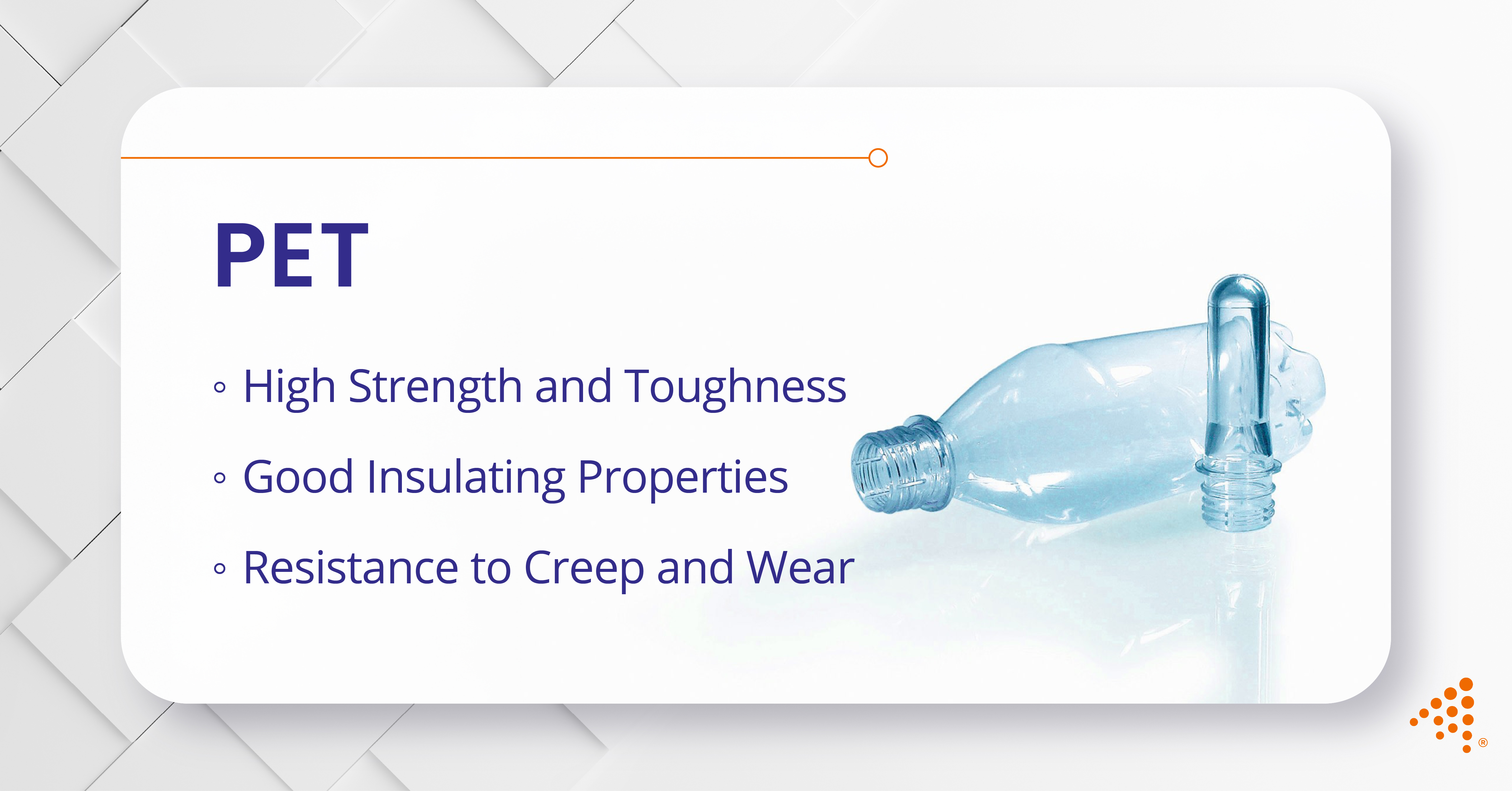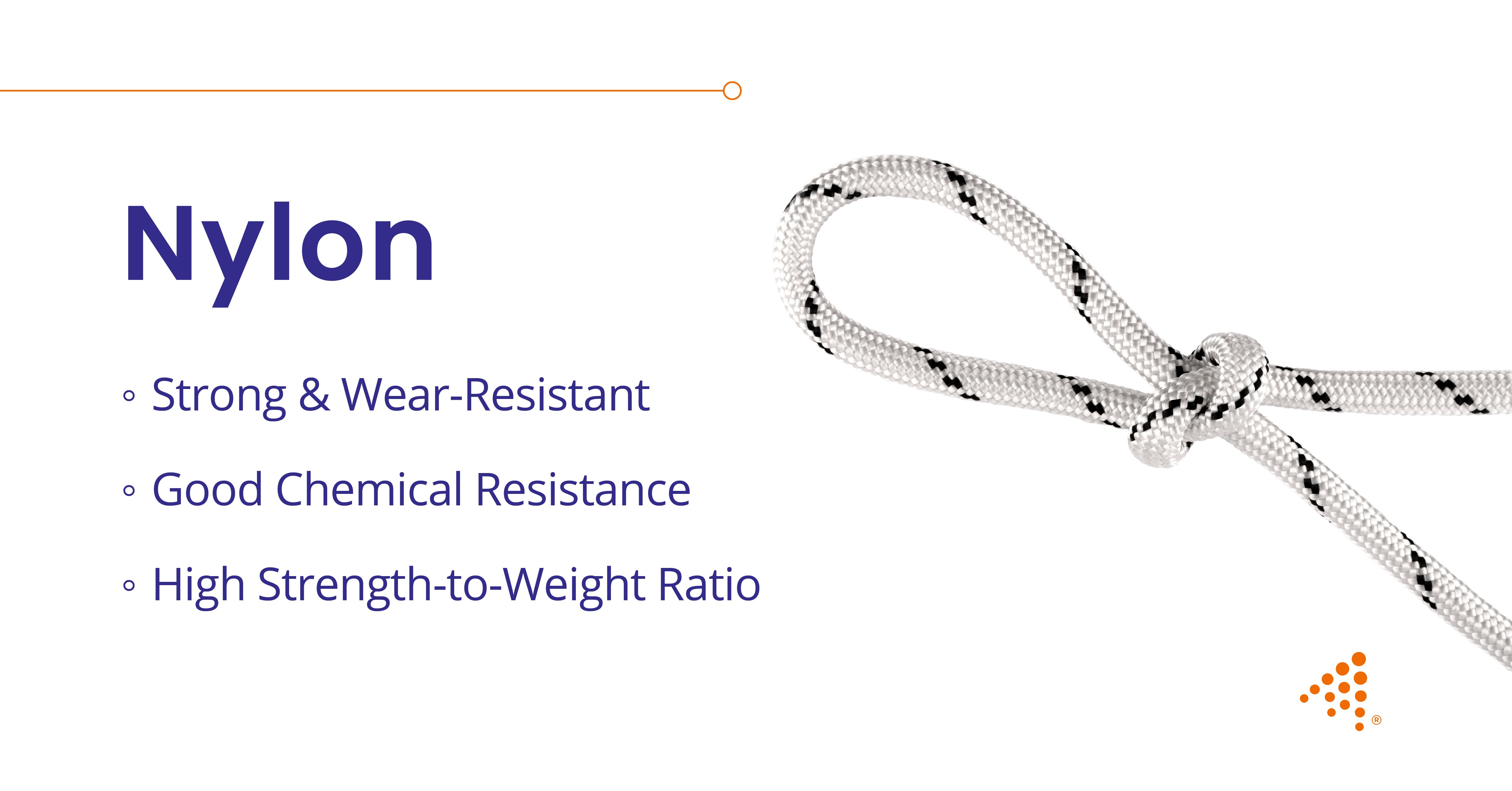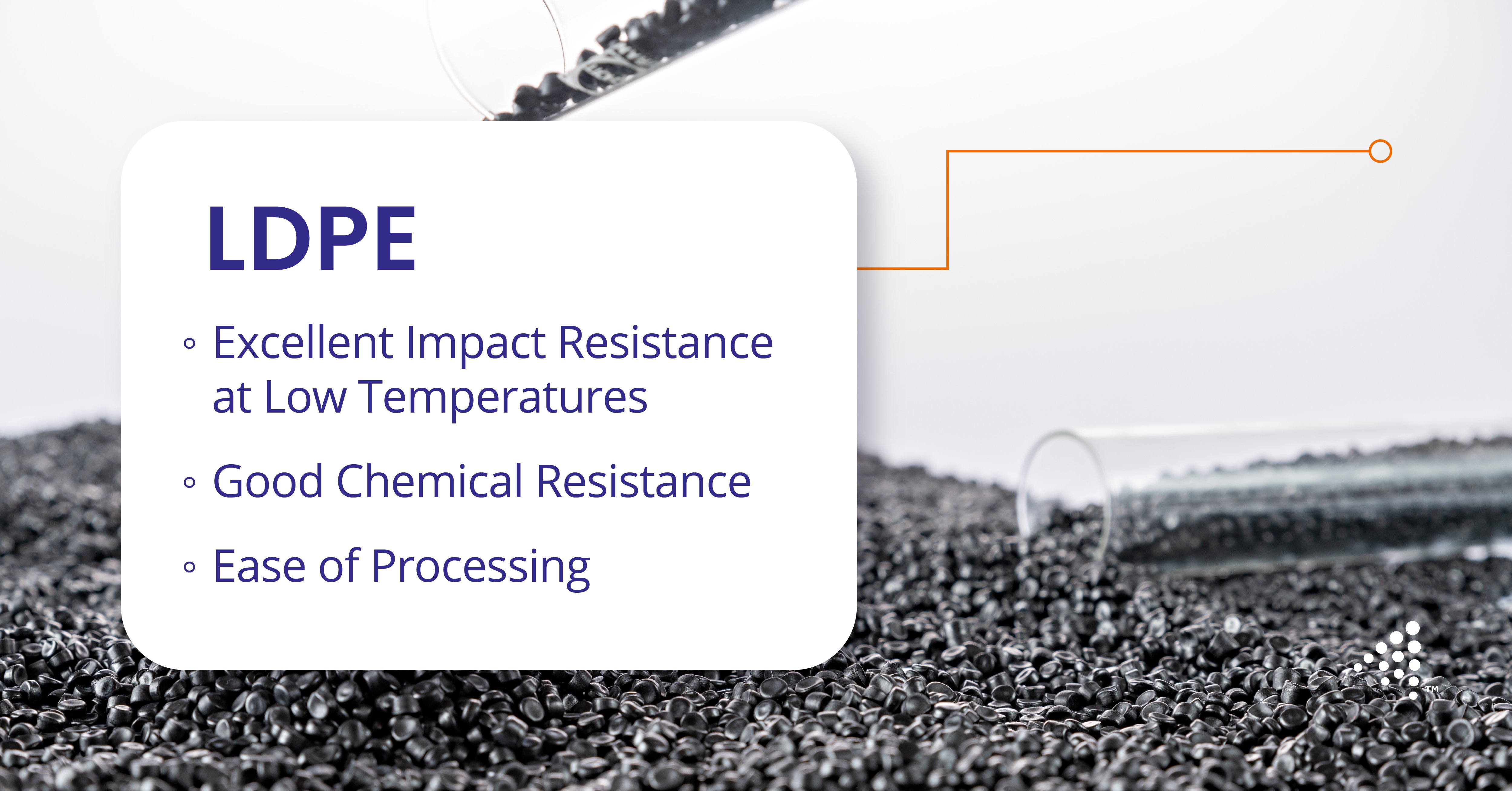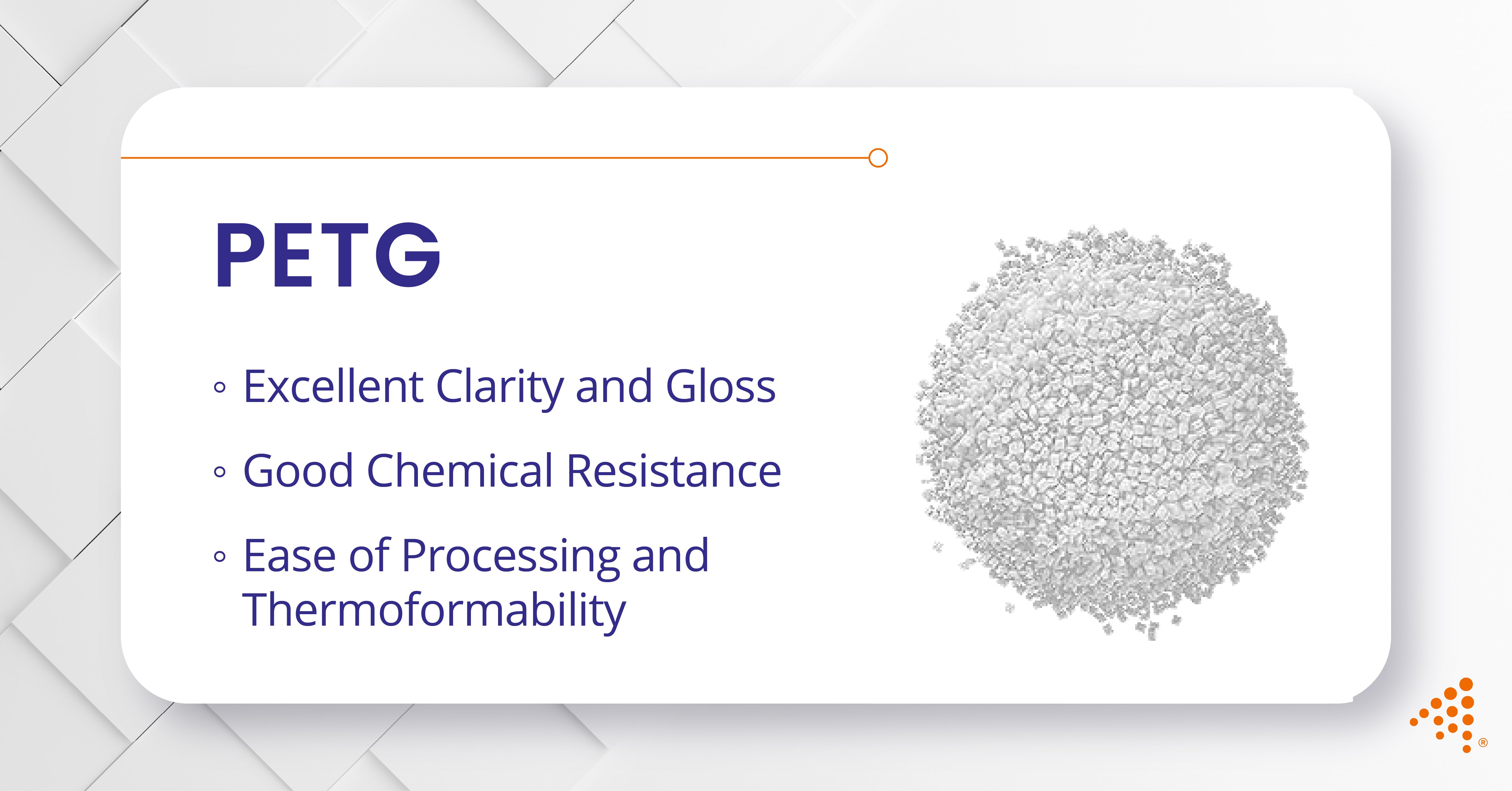Nylon (Polyamide): Durable and Versatile for Many Applications
Nylon (Polyamide): A Tough, Durable Resin for a Variety of Uses
5 min read
Nick Erickson : Jul 28, 2025 9:09:00 AM

Polyethylene Terephthalate (PET) is a widely used thermoplastic resin known for its strength, chemical resistance, and versatility in high-volume manufacturing. It is especially popular in industries like food packaging, medical devices, and consumer goods due to its reliable performance in various environments and its compatibility with design and manufacturing services.
PET exhibits impressive mechanical strength and impact resistance, making it a durable option for both rigid and flexible products. Its toughness contributes to excellent dimensional stability and resistance to breakage under stress, pressure, or repeated use.
PET resists attack from water, alcohols, and many acids, making it suitable for packaging a wide range of consumer and industrial goods. This chemical stability helps prevent degradation when in contact with food, beverages, or cleaning agents.
One of PET’s standout qualities is its ability to achieve high clarity and an attractive, glossy surface finish. This visual appeal makes it ideal for consumer packaging where product visibility and shelf presentation are important.
PET provides an effective barrier against gases and moisture, helping to preserve the contents of packaging by minimizing oxidation and contamination. This characteristic supports long shelf life for both food and pharmaceutical products.
PET is widely recyclable and is one of the most commonly collected plastics in global recycling programs. It can be reprocessed into new containers, fibers, or films, supporting sustainability goals and circular economy initiatives.
PET can be easily thermoformed into various shapes without sacrificing structural integrity.
PET maintains its shape and function under mechanical load over time, showing good resistance to creep and surface wear. This makes it suitable for load-bearing parts in both medical injection molding and industrial use.
PET has stable dielectric properties, making it useful as an electrical insulator in low- to moderate-voltage applications. It is also used in films for capacitors and insulating tapes.
PET is available in grades that meet FDA and United States Pharmacopeia (USP) requirements, making it a trusted material for food containers, medical packaging, and labware.
Partner with Aprios for end-to-end design and manufacturing services that bring your PET-based products to life with precision and speed.
Thanks to its high strength, clarity, and barrier properties, PET is extensively used across industries supported by end-to-end manufacturing services.
PET is best known for its role in beverage bottles, including those for water, soft drinks, and juices. Its transparency, strength, and resistance to carbonation make it ideal for pressurized containers. PET is also widely used in food trays, clamshell containers, and other snack containers due to its clarity and safety profile.
In the healthcare sector, PET is used for blister packs, sterile containers, and medical-grade films. Its ability to maintain a strong barrier against moisture and oxygen is critical in protecting medications, diagnostic kits, and sensitive equipment. Medical-grade PET is often used in medical injection molding processes to create precise, single-use components.
When spun into fibers, PET becomes polyester—a cornerstone of the textile industry. It’s used in everything from clothing and upholstery to industrial fabrics and medical wearables. PET fibers are valued for their durability, wrinkle resistance, and ease of care.
PET films are used as insulation layers in flexible printed circuits, capacitors, and cable wraps. Its dielectric strength and dimensional stability under heat and humidity make it a reliable choice for electrical and electronic assemblies.
PET (and its copolymer PETG) is growing in popularity as a filament in 3D printing due to its strength, chemical resistance, and low shrinkage. It’s used in prototyping as well as end-use parts where clarity and impact resistance are needed.
In automotive design, PET is used for light covers, interior trim components, and under-the-hood applications. Its resistance to wear, heat, and fuel additives makes it a suitable replacement for metal or more expensive engineered plastics in certain assemblies.
PET is found in everyday items such as reusable containers, cosmetic bottles, and cleaning product packaging. Its balance of performance, cost, and recyclability makes it a go-to material for consumer-facing goods that require strength and transparency.
PET films are also used in construction applications such as vapor barriers, reflective insulation, and protective window films. These applications benefit from PET’s thermal stability, toughness, and ability to withstand UV exposure.
Read More About The Ultimate Guide to ABS for High-Performance Manufacturing
PET’s performance can be enhanced through processing aids and additives that make it adaptable for medical injection molding, precision manufacturing, and more.
Nucleating agents are used to control the crystallization rate of PET, improving dimensional stability, clarity, and cycle time during injection molding or extrusion. In medical and food packaging applications, faster crystallization helps create thin, strong walls without sacrificing transparency.
To enhance PET’s toughness, especially in cold or high-impact environments, elastomeric modifiers can be blended into the base resin. These additives improve crack resistance and are often used in packaging, consumer goods, and automotive components where durability is key.
PET is susceptible to degradation when exposed to prolonged UV radiation. UV stabilizers are added to protect its molecular structure and preserve strength and color—critical in outdoor applications like construction films or automotive parts.
PET is highly receptive to colorants, making it easy to customize for branding or product differentiation. In medical devices and packaging, color can also serve functional roles such as dosage identification, labeling, or contamination prevention.
In film applications, antiblock agents help prevent layers of PET from sticking together during winding or stacking. Slip agents reduce surface friction, making PET sheets and films easier to handle and process, particularly in high-speed packaging environments.
For applications that demand greater rigidity or strength, such as automotive parts or electronic housings, PET can be reinforced with glass fibers or mineral fillers. These formulations boost structural integrity while maintaining dimensional precision during injection molding.
To improve PET’s gas and moisture barrier properties, additives like nanoclays or special coatings can be used. These modifications are essential in food and pharmaceutical packaging to extend shelf life and ensure product stability.
In electrical and electronic uses, PET can be modified with flame retardant additives to meet fire safety standards. These formulations slow ignition and reduce flame spread, making PET suitable for cable insulation, circuit boards, and appliance housings.
Additives like lubricants and mold release agents are commonly used to enhance flow properties and prevent sticking in molds during processing. These aids are especially useful in precision medical injection molding, where surface finish and dimensional accuracy are critical.
Connect with our materials experts today to discover PET grades optimized for medical injection molding, packaging, or electrical insulation.
While PET is a highly versatile and widely used thermoplastic, it does have some limitations that must be considered when selecting materials for specific design, performance, or regulatory requirements, particularly in sensitive industries like medical injection molding or high-performance electronics.
Unmodified PET can become brittle in very cold environments, making it prone to cracking or fracturing under impact. This can limit its use in certain outdoor or refrigerated applications unless impact modifiers are added.
PET is hygroscopic, meaning it readily absorbs moisture from the air. If not properly dried before processing, the absorbed water can degrade the polymer chains during melt processing, leading to reduced mechanical properties and surface defects in the final part.
Although PET offers good thermal stability for many applications, its upper service temperature is typically limited to around 120–150°C (248–302°F). This makes it unsuitable for high-temperature environments without heat-stabilizing modifications.
PET has a relatively low surface energy, which can hinder adhesion with coatings, inks, or adhesives. For packaging or medical applications that require labeling or printing, surface treatments like corona discharge or plasma treatment may be necessary to ensure adequate bonding.
While PET resists many chemicals, it is vulnerable to degradation when exposed to strong alkalis or caustic substances. This restricts its use in certain cleaning, sterilization, or industrial processing environments.
Read More About Guide to Polypropylene (PP): A Versatile Material for Manufacturing
PET’s unique balance of clarity, strength, and chemical resistance makes it a highly sought-after material across a wide range of industries, including food packaging, textiles, and medical injection molding. Its recyclability, processability, and barrier properties contribute to its broad appeal, particularly in applications where hygiene, durability, and visual presentation are critical.
Whether you’re designing packaging that needs to withstand sterilization or producing injection molded parts that require high dimensional stability and surface finish, PET offers a dependable solution that can be customized for performance and sustainability.
Explore our design and manufacturing services to see how PET can elevate your next project. Whether you need medical-grade precision or large-scale packaging solutions, we tailor every step to your product needs.
Contact Aprios today to speak with our team of thermoplastic and material specialists!

Nylon (Polyamide): A Tough, Durable Resin for a Variety of Uses

Low-Density Polyethylene (LDPE) is a flexible, cost-effective thermoplastic resin commonly used in a variety of industries. Known for its pliability,...

Polyethylene terephthalate glycol (PETG) is a versatile thermoplastic polyester resin gaining significant traction across various industries due to...